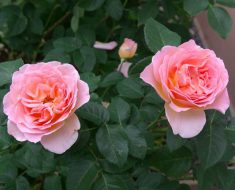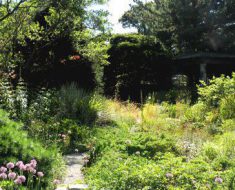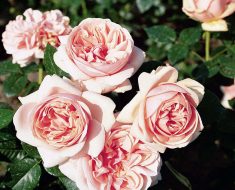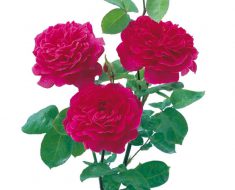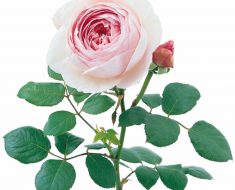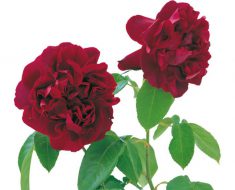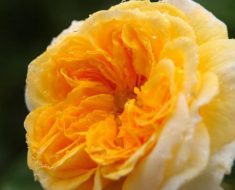The beautiful, fragrant and long-lasting rose EMILY BRONTE was named after the famous novelist Emily Bronte, author of Wuthering Heights. The delicate color of the flowers is emphasized by the large, shiny, green foliage. The English rose EMILY BRONTE is grown in almost every corner of the garden and in pots.
CHARACTERISTICS OF EMILY BRONTE ROSES
- Group – English Roses (English Roses)
- Basic form – shrub
- Height – 1.2 m
- Diameter – 1.1 m
- Bush shape – round
- Color of the flower – soft pink-apricot shades turn into cream with age
- Number of petals – more than 40
- Flower shape – flat rosette, densely double
- Flower size – 8 – 12 cm
- Flowering shape – clusters
- Flowering type – repetitive
- Aroma – intense; citrus notes are woven into the aroma in the style of Old Roses
- Foliage – dark green, leathery, shiny, abundant
- Shoots – erect, may droop slightly under the weight of flowers
- Features – almost continuous flowering; the flower fully opened shows a golden button, consisting of pistils and stamens; actively growing
- Resistance to powdery mildew – high
- Resistance to black spot – high
- Cold resistance – 5 – 11 USDA zones
- Breeder – D. Austin
- Catalog name – Ausarnshaw
- Year of introduction into cultivation – 2018
- Soil – chalky, clayey, loam, sandy
- pH – may be small fluctuations from neutral
- Drainage – mandatory
- Plot – sunny / partial shade
- Container – yes
- Standard – yes, high
- Planting types – various types of mixed plantings, hedges, rose gardens, fragrant gardens
CARE OF ENGLISH ROSE EMILY BRONTE
PLANTING EMILY BRONTE ROSES
All roses prefer nutritious and draining soil. The planting hole for the plant should be such that the root system of the EMILY BRONTE rose seedling fits freely in it. This should be the case if you purchased planting material with an open or closed root system. Do the same with a rose when planting a rose in a container. The difference between planting is that when planting a flower with an open root system, compost with granular fertilizers or rotted manure must be poured onto the bottom of the pit. As a rule, potted seedlings grow in a prepared mixture of soil and fertilizers, and therefore do not need additional feeding in the first year after planting.
It is advisable to choose a sunny place for planting the EMILY BRONTE, protected from winter winds. This rose grows well in slightly shaded areas. Keep in mind that the plant should bask in the sun for at least 6 hours. Drainage and groundwater height are also very important. Stagnation of water at the roots is unacceptable due to the appearance of decay as a result.
WATERING EMILY BRONTE ROSES
Water roses as needed, or when the top ball of earth dries 3-5 cm deep. For 1 watering of an adult English rose EMILY BRONTE, you will need from 10 liters of water. It should be warm and well-kept. Watered in portions over the entire root area, but not over the bush. The best time to water is in the evening. In dry and hot weather, it is recommended to spray the flowers in the evening.
FEEDING EMILY BRONTE ENGLISH ROSE
Healthy and fragrant EMILY BRONTE rose is the result of proper care. Strongly affect the state of the plant feeding. Much depends on the soil. Roses growing on poor soils are fed more often than those growing on black soil. Potted roses are also fed more often, but in smaller doses. Fertilizers are used both organic and industrial. They can be both liquid and solid (granular).
Solid fertilizers are scattered under the bush and with each watering or rain they will dissolve. So they enrich the soil with useful substances for a longer time. Liquid ready-made fertilizers immediately saturate the soil around the EMILY BRONTE English rose. But you must definitely pay attention to the dosage of the drug, because you can overfeed the flower. It can release too many new shoots if given excess nitrogen.
Most often, roses are fed 3-4 times a season. The first time they are fed with the arrival of heat and the first irrigation with nitrogen-containing fertilizers. Subsequent dressings should contain more potassium and phosphorus, which stimulate flowering. Nitrogen should also be present, but in smaller doses. The last dressing should contain a minimum of nitrogen compounds that stimulate the growth of new shoots. Young late autumn growth will not overwinter.
PRUNING EMILY BRONTE ROSES
Since the rose EMILY BRONTE belongs to bush roses (scrubs) and is a rather powerful plant, it must be pruned. Pruning is in autumn, early spring, summer and winter. Faded inflorescences are constantly cut off in the summer so that new ones appear, and also so that the plant looks well-groomed.
In the first year after planting, the shoots are shortened in late autumn by a third. The extreme point of growth should look out of the bush so that the bush is well ventilated next season. In a mature plant, old shoots are removed and the main ones are shortened by ½ or ⅔. This can be done in winter, when the plant is completely dormant. Early spring pruning involves removing / shortening damaged and diseased shoots. If you have not pruned the EMILY BRONTE rose either in autumn or winter, you can shorten the main shoots in the spring. But this must be done before the buds begin to grow.
WEEDING AND LOOSING OR MULCHING AROUND EMILY BRONTE ROSES
To make the EMILY BRONTE grow comfortably, the soil around the bush is regularly loosened and weeded or mulched. When weeding and loosening are done, they do it carefully so as not to damage the young roots. Also, the loose top layer of the earth allows moisture and oxygen to get to the root system faster.
It will help to keep the rose and mulching clean. It will prevent weeds from sprouting in large quantities and will retain moisture in the soil longer. Do not use leaves, conifer bark, grass, fresh compost or manure for mulching. Leave the trunk circle with a diameter of 5-10 cm not closed with mulch. This will allow you to notice problems in time: insects or diseases.
DISEASES AND PESTS OF THE ENGLISH ROSE EMILY BRONTE
The EMILY BRONTE rose may have problems with poor care or due to weather conditions. These are fungal diseases and insects. Typical rose diseases are powdery mildew, black spot and rust. Botrytis is also possible in wet weather. You can fight them with fungicides. Aphids, spider mites, leaf worms, scale insects, leafhoppers and sawflies are the most common pests of roses. They are destroyed with insecticides. However, you can strengthen the immune system by feeding micro and macro elements.
USING THE EMILY BRONTE ROSE The EMILY BRONTE
rose is a versatile English rose. It can become part of any flower garden, in any style. As mentioned above, it can be grown in various pots, pots, containers. Another way is the standard form. The only thing to consider is the height of the trunk. D. Austin’s rose EMILY BRONTE has long shoots and light color of flowers, and in order to have a beautiful and neat rose, it is better to choose a tall stem.
Various plants can coexist with a rose, with all kinds of color of leaves and flowers. The dark flowers of other plants will accentuate the pallor of EMILY BRONTE flowers, which can harmonize perfectly in an English, French, Italian or Japanese garden. This rose will decorate even a standard fence made of an ordinary metal profile.
Enjoy your cultivation!
